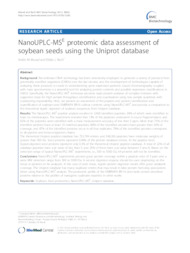NanoUPLC-MSE proteomic data assessment of soybean seeds using the Uniprot database.
NanoUPLC-MSE proteomic data assessment of soybean seeds using the Uniprot database.
Author(s): MURAD, A. M.; RECH FILHO, E. L.
Summary: Background: Recombinant DNA technology has been extensively employed to generate a variety of products from genetically modified organisms (GMOs) over the last decade, and the development of technologies capable of analyzing these products is crucial to understanding gene expression patterns. Liquid chromatography coupled with mass spectrometry is a powerful tool for analyzing protein contents and possible expression modifications in GMOs. Specifically, the NanoUPLC-MSE technique provides rapid protein analyses of complex mixtures with supported steps for high sample throughput, identification and quantization using low sample quantities with outstanding repeatability. Here, we present an assessment of the peptide and protein identification and quantification of soybean seed EMBRAPA BR16 cultivar contents using NanoUPLC-MSE and provide a comparison to the theoretical tryptic digestion of soybean sequences from Uniprot database. Results: The NanoUPLC-MSE peptide analysis resulted in 3,400 identified peptides, 58% of which were identified to have no miscleavages. The experiment revealed that 13% of the peptides underwent in-source fragmentation, and 82% of the peptides were identified with a mass measurement accuracy of less than 5 ppm. More than 75% of the identified proteins have at least 10 matched peptides, 88% of the identified proteins have greater than 30% of coverage, and 87% of the identified proteins occur in all four replicates. 78% of the identified proteins correspond to all glycinin and betaconglycinin chains. The theoretical Uniprot peptide database has 723,749 entries, and 548,336 peptides have molecular weights of greater than 500 Da. Seed proteins represent 0.86% of the protein database entries. At the peptide level, trypsin-digested seed proteins represent only 0.3% of the theoretical Uniprot peptide database. A total of 22% of all database peptides have a pI value of less than 5, and 25% of them have a pI value between 5 and 8. Based on the detection range of typical NanoUPLC-MSE experiments, i.e., 500 to 5000 Da, 64 proteins will not be identified. Conclusions: NanoUPLC-MSE experiments provide good protein coverage within a peptide error of 5 ppm and a wide MW detection range from 500 to 5000 Da. A second digestion enzyme should be used depending on the tissue or proteins to be analyzed. In the case of seed tissue, trypsin protein digestion results offer good databank coverage. The Uniprot database has many duplicate entries that may result in false protein homolog associations when using NanoUPLC-MSE analysis. The proteomic profile of the EMBRAPA BR-16 seed lacks certain described proteins relative to the profiles of transgenic soybeans reported in other works.
Publication year: 2012
Types of publication: Journal article
Keywords: NanoUPLC-MSE, Seed proteomics, Soja, Soybean, Uniprot database
Observation
Some of Embrapa's publications are published as ePub files. To read them, use or download one of the following free software options to your computer or mobile device. Android: Google Play Books; IOS: iBooks; Windows and Linux: Calibre.
Access other publications
Access the Agricultural Research Database (BDPA) to consult Embrapa's full library collection and records.
Visit Embrapa Bookstore to purchase books and other publications sold by Embrapa.

